 |
| |
Feeding Recommendations The dietary choline requirements for poultry and swine depends upon such factors as the rate of growth, rate of egg production, nutrient composition of the ration, daily feed intake, environmental conditions, and management factors. Choline deficiency in companion animals is fairly well characterized and is preventable by the addition of choline salts to the diet. A choline deficiency has been produced in several species of animals. In poultry, the deficiency is characterized by a fatty degeneration of the liver, a reduced rate of growth, perosis and, in mature birds, a decrease in egg production and hatchability. In swine, a deficiency results in a reduced rate of growth, uncoordinated movements, reduced number of total and live pigs per litter, fatty degeneration of the liver and kidney damage. Corn and other grains are poor sources of this vitamin. For this reason, practical diets for poultry and swine should be supplemented with choline. The most common source of choline for animal diets is choline chloride, which on a pure basis contains 86.79% choline.Dietary Requirements Chart
All information, recommendations and suggestions appearing in the above chart concerning the requirements of choline are based upon tests and data believed to be reliable; however, it is the user's responsibility to determine the suitability for his own use of choline being described herein. Since the actual use by others is beyond our control, no guarantee, expressed or implied, is made by our end, Incorporated as to the effects of such use or the results to be obtained, nor does our end, Incorporated assume any liability arising out of use, by others, of choline referred to herein. Nor is the information herein to be construed as absolutely complete since additional information may be necessary or construed as permission or as a recommendation to infringe any patent
|
|||||||||||||||||||||||||||||||||||||||||||||||||||||||||||||||||||||||||||||||||||||||||||||||
